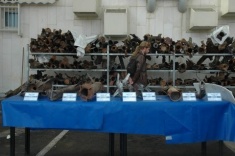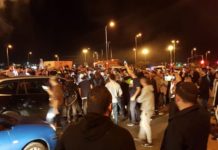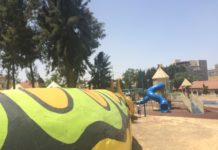
I am always encouraged by groups like these who come to Sderot to show their solidarity with the shell-shocked residents. Having grown up in Maine all my life, I know that to come to a city like Sderot at a time like this, is not easy. The residents of Sderot, however, have been living through this rocket terror for the past seven years. Not a day goes by, where they can experience life as I knew it back in Maine -quiet, peaceful, and safe.
The first stop during the visit was at the Qassam rocket gallery, located in the Sderot police station, where hundreds of rockets that have hit Sderot and the surrounding area, are stored away. It is always a rather unnerving site. I can’t think of one police station in the world that has this kind of exhibit-an exhibit which is updated almost on a daily basis with new rockets.
One of the police officers, Barak, explained to the group that there are several different Palestinian terror organizations in Gaza who launch these rockets over. Each organization colors their rocket differently. Hamas’s Qassam rockets, for example, are identified by their red and green colors. Al-Aqsa Martyrs Brigades, the armed wing of Fatah, color their rockets yellow with Arabic writing at the tail. Islamic Jihad rockets are identified by their red and blue colors.
After the rocket gallery, the group visited a local Sderot elementary school, Alon Madaim. The Americans presented the principal with board games for the students, to give them something fun to do during recess during periods of rocket fire when they must remain inside the protected classrooms.
We stood in the school library, as the principal of the school, Leora Fima, spoke about the added responsibility of making sure that her 150 students are both safe and psychologically well in her school. She said that many of the teachers had to learn to be both educators and psychologists, as students bring the stress and anxiety of living with rockets into class.
I think that the most powerful point was made when Principal Fima related to the American visitors the following story.
A few months ago, the President of Israel, Shimon Peres, came to visit the Alon Madaim school. During the visit, a fifth grader named Omer, who no longer studies in the school, approached the president with a question. “How can we stop the rocket fire, without hurting the children in Gaza ?
Principal Fima explained that although the rocket fire has affected the children in her school-grades and exams scores have dropped–it has not changed their regard for innocent human life.
On the way back to boarding the bus, one elderly American commented to me, that he hoped that the children in Gaza were being taught to value the lives of the children in Sderot in the same way.
“We can only hope,” I replied.











